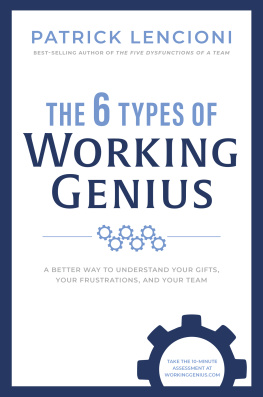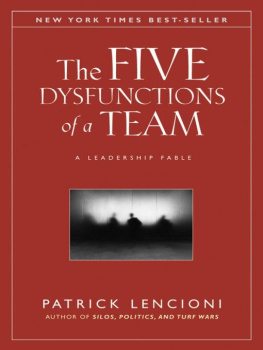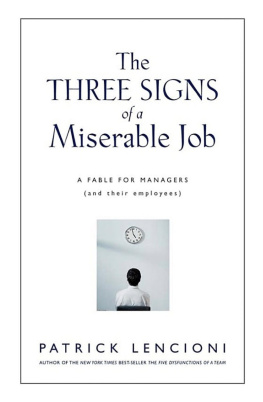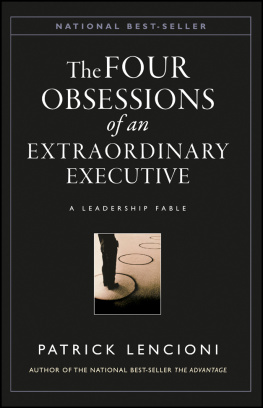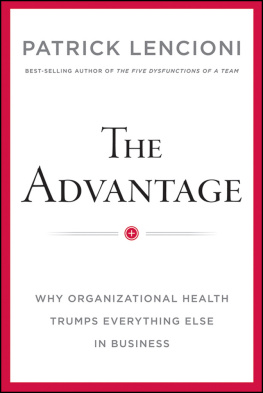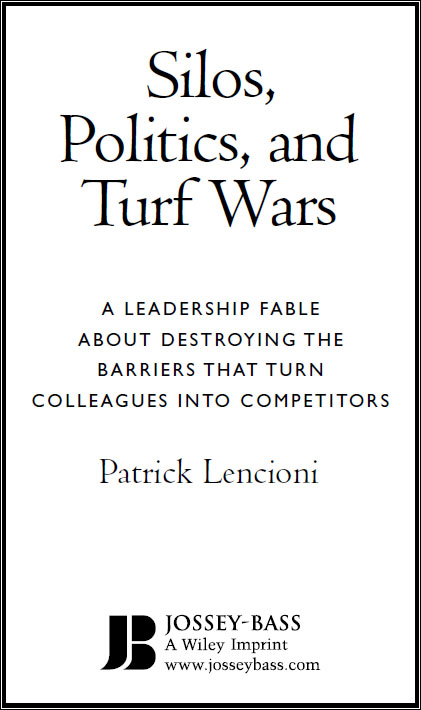Table of Contents
Also by Patrick Lencioni
The Five Temptations of a CEO
The Four Obsessions of an Extraordinary Executive
The Five Dysfunctions of a Team
Death by Meeting
Overcoming the Five Dysfunctions of a Team
The Truth About Employee Engagement
The Three Big Questions for a Frantic Family
Getting Naked
The Advantage
The Ideal Team Player
This book is dedicated to my dear friends at The Table Group: Amy, Tracy, Karen, Michele, and Jeff. Your dedication and talent amaze me more every day and cannot be put into words adequately.
INTRODUCTION
Silos. Its a word I first started hearing in a corporate context more than twenty years ago, always used to describe departmental politics and territoriality within organizations. At the time, I thought it was one of those terms that would eventually go away like so much other management jargonbut it hasnt.
In fact, today the word seems to provoke the same level of frustration that it did back then, if not more. When I told some of my clients that I was planning to write a book about silos, they seemed to have a universally visceral reaction: Pleeease write that book. The silos in this company are driving me crazy!
Which would seem to be a good thingproposing a solution to a problem that people are hungry to solveexcept that my view of silos might not be what some leaders expect to hear.
Thats because many executives Ive worked with who struggle with silos are inclined to look down into their organizations and wonder, Why dont those employees just learn to get along better with people in other departments? Dont they know were all on the same team? All too often this sets off a well-intentioned but ill-advised series of actionstraining programs, memos, postersdesigned to inspire people to work better together.
But these initiatives only provoke cynicism among employeeswho would love nothing more than to eliminate the turf wars and departmental politics that often make their work lives miserable. The problem is, they cant do anything about it. Not without help from their leaders.
And while the first step those leaders need to take is to address any behavioral problems that might be preventing executive team members from working well with one anotherthat was the thrust of my book The Five Dysfunctions of a Teameven behaviorally cohesive teams can struggle with silos. (Which is particularly frustrating and tragic because it leads well-intentioned and otherwise functional team members to inappropriately question one anothers trust and commitment to the team.)
To tear down silos, leaders must go beyond behaviors and address the contextual issues at the heart of departmental separation and politics. The purpose of this book is to present a simple, powerful tool for addressing those issues and reducing the pain that silos cause. And that pain should not be underestimated.
Silosand the turf wars they enabledevastate organizations. They waste resources, kill productivity, and jeopardize the achievement of goals.
But beyond all that, they exact a considerable human toll too. They cause frustration, stress, and disillusionment by forcing employees to fight bloody, unwinnable battles with people who should be their teammates. There is perhaps no greater cause of professional anxiety and exasperationnot to mention turnoverthan employees having to fight with people in their own organization. Understandably and inevitably, this bleeds over into their personal lives, affecting family and friends in profound ways.
The good news is that this is all immensely avoidable. In fact, I have never used a tool with clients that has been so universally and successfully adopted.
Like my other books, Silos, Politics, and Turf Wars is written in the form of a realistic but fictional story. Unlike those books, however, it involves not one but a host of different companies struggling to eliminate infighting from their organizations and bring about a sense of alignment and sanity.
I sincerely hope that this book helps you do the same.
The Fable
PART ONE
EntrepreneurialAmbition
HONEYMOON
Five months. Thats how long it took for Jude Cousins entrepreneurial passion and excitement to fade into anxiety and panic. While it was true that he had never started a company before and didnt know exactly what to expect, five months just seemed like too short of a honeymoon to Jude.
To be fair, Cousins Consulting wasnt really a company. Just a consulting practice operating out of a spare bedroom in Judes home. No employees. No politics. Just Jude, his passion, and three clients. Two of which, unfortunately, were already in jeopardy.
HATCH
For the seven years prior to starting his consulting firm, Jude had received nothing but encouragement and recognition in his career, which only served to magnify his frustration as an entrepreneur.
After a brief and unsatisfying postcollege stint in journalism, Jude took a job in the marketing department at Hatch Technology, a fast-growing company that developed financial software for consumers and small businesses. Beginning his career at Hatch as a copy editor, Jude gradually worked his way through every department in the marketing division, with detours into product management and operations.
As a result of his work ethic, humility, and general curiosity about whatever he was doingnot to mention the rapid growth of the companypromotions came frequently for Jude. At the age of twenty-eight, four years after joining Hatch, he was named director of corporate communication, reporting directly to the companys vice president of marketing.
Judes career trajectory, though impressive on its own merit, was all the more amazing given his relative lack of passion for technology. Not particularly inspired by the charter of enticing people to buy software, he knew that the secret to his success had everything to do with his insatiable passion for learning. As Jude liked to tell his friends, he felt like he was being paid to go to business school.
And being just one level removed from the senior executive team meant Jude was constantly exposed to challenges related to every aspect of running a company, from strategy to structure to management. All of which fascinated him.
Still, he was not content to have his education limited to one company. So Jude began volunteering to sit on a variety of advisory boards for small but growing companies in the area, all of whom were happy to have someone of his talent providing advice, especially when that advice was free of charge.
Jude was eagerly soaking up everything he couldand forming strong opinions about how he would run a company, which he had come to believe was the ultimate goal of his professional life. Anyone who knew Jude assumed he would one day be a CEO.
SMOOTH SAILING
On a personal level, Judes life certainly seemed to be heading in the right direction.
He and his wife of three years, Theresa, were hoping to start a family as soon as possible. They had recently bought their first home, a small but attractive rancher in Orinda, just over the hills from the San Francisco Bay. Though not wealthy, they were financially more secure than ever, and more important, had amassed a close-knit collection of friends in the area. They were involved in their local church, and were quick to help friends, neighbors, and family members who needed a hand.


